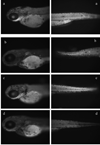CYP1B1 knockdown does not alter synergistic developmental toxicity of polycyclic aromatic hydrocarbons in zebrafish (Danio rerio)
- PMID: 18378296
- PMCID: PMC2516962
- DOI: 10.1016/j.marenvres.2008.02.030
CYP1B1 knockdown does not alter synergistic developmental toxicity of polycyclic aromatic hydrocarbons in zebrafish (Danio rerio)
Abstract
Polycyclic aromatic hydrocarbons (PAHs) are contaminants increasing in the environment largely due to burning of fossil fuels. Our previous work identified a synergistic toxicity interaction in zebrafish embryos occurring when PAHs that are agonists for the aryl hydrocarbon receptor (AHR) co-occur with PAHs that are CYP1A inhibitors. This toxicity is mediated by the AHR2, and morpholino knockdown of CYP1A exacerbated toxicity. This study tested two hypotheses: (1) in the absence of functional CYP1A, metabolism of PAHs is shunted towards CYP1B1, which has been shown in mammals to produce more reactive metabolites of PAHs; alternatively, (2) CYP1B1 serves a protective role similar to CYP1A. We used a morpholino approach to knockdown CYP1B1 alone and in co-knockdown with CYP1A to determine whether we could alter deformities caused by synergistic toxicity of PAHs. CYP1B1 knockdown was not different from non-injected controls; nor were CYP1B1+CYP1A co-knockdown deformities different from CYP1A knockdown alone. These data suggest that CYP1B1 is not a significant factor in causing synergistic toxicity of PAHs, nor, in contrast to CYP1A, in providing protection.
Figures


Similar articles
-
Knockdown of AHR1A but not AHR1B exacerbates PAH and PCB-126 toxicity in zebrafish (Danio rerio) embryos.Aquat Toxicol. 2013 Oct 15;142-143:336-46. doi: 10.1016/j.aquatox.2013.09.007. Epub 2013 Sep 16. Aquat Toxicol. 2013. PMID: 24084256 Free PMC article.
-
The role of the aryl hydrocarbon receptor pathway in mediating synergistic developmental toxicity of polycyclic aromatic hydrocarbons to zebrafish.Toxicol Sci. 2006 Aug;92(2):526-36. doi: 10.1093/toxsci/kfl011. Epub 2006 May 9. Toxicol Sci. 2006. PMID: 16687390
-
Zebrafish cardiotoxicity: the effects of CYP1A inhibition and AHR2 knockdown following exposure to weak aryl hydrocarbon receptor agonists.Environ Sci Pollut Res Int. 2015 Jun;22(11):8329-38. doi: 10.1007/s11356-014-3969-2. Epub 2014 Dec 23. Environ Sci Pollut Res Int. 2015. PMID: 25532870 Free PMC article.
-
Synergistic induction of AHR regulated genes in developmental toxicity from co-exposure to two model PAHs in zebrafish.Aquat Toxicol. 2007 Dec 30;85(4):241-50. doi: 10.1016/j.aquatox.2007.09.005. Epub 2007 Sep 14. Aquat Toxicol. 2007. PMID: 17964672 Free PMC article.
-
Developmental toxicity of 4-ring polycyclic aromatic hydrocarbons in zebrafish is differentially dependent on AH receptor isoforms and hepatic cytochrome P4501A metabolism.Toxicol Appl Pharmacol. 2006 Dec 15;217(3):308-21. doi: 10.1016/j.taap.2006.09.018. Epub 2006 Oct 7. Toxicol Appl Pharmacol. 2006. PMID: 17112560
Cited by
-
A Review of the Functional Roles of the Zebrafish Aryl Hydrocarbon Receptors.Toxicol Sci. 2020 Dec 1;178(2):215-238. doi: 10.1093/toxsci/kfaa143. Toxicol Sci. 2020. PMID: 32976604 Free PMC article. Review.
-
Hepatic metabolism affects the atropselective disposition of 2,2',3,3',6,6'-hexachlorobiphenyl (PCB 136) in mice.Environ Sci Technol. 2015 Jan 6;49(1):616-25. doi: 10.1021/es504766p. Epub 2014 Dec 10. Environ Sci Technol. 2015. PMID: 25420130 Free PMC article.
-
Null cyp1b1 Activity in Zebrafish Leads to Variable Craniofacial Defects Associated with Altered Expression of Extracellular Matrix and Lipid Metabolism Genes.Int J Mol Sci. 2021 Jun 16;22(12):6430. doi: 10.3390/ijms22126430. Int J Mol Sci. 2021. PMID: 34208498 Free PMC article.
-
Ahr2-dependence of PCB126 effects on the swim bladder in relation to expression of CYP1 and cox-2 genes in developing zebrafish.Toxicol Appl Pharmacol. 2012 Dec 1;265(2):166-74. doi: 10.1016/j.taap.2012.09.023. Epub 2012 Oct 2. Toxicol Appl Pharmacol. 2012. PMID: 23036320 Free PMC article.
-
Gene knockdown by morpholino-modified oligonucleotides in the zebrafish (Danio rerio) model: applications for developmental toxicology.Methods Mol Biol. 2012;889:51-71. doi: 10.1007/978-1-61779-867-2_5. Methods Mol Biol. 2012. PMID: 22669659 Free PMC article.
References
-
- Andreasen EA, Spitsbergen JM, Tanguay RL, Stegeman JJ, Heideman W, Peterson RE. Toxicological Sciences. 2002;68:403–419. - PubMed
-
- Billiard SM, Timme-Laragy AR, Wassenberg DM, Cockman C, Di Giulio RT. Toxicological Sciences. 2006;92:526–536. - PubMed
-
- Galvan N, Jaskula-Sztul R, Macwilliams PS, Czuprynski CJ, Jefcoate CR. Toxicology and Applied Pharmacology. 2003;193:84–96. - PubMed
-
- Godard CA, Goldstone JV, Said MR, Dickerson RL, Woodin BR, Stegeman JJ. Biochemical and Biophysical Research Communications. 2005;331:1016–1024. - PubMed
-
- Shimada T, Gillam EM, Oda Y, Tsumura F, Sutter TR, Guengerich FP, et al. Chemical Research in Toxicology. 1999;12:623–629. - PubMed
Publication types
MeSH terms
Substances
Grants and funding
LinkOut - more resources
Full Text Sources
Molecular Biology Databases

